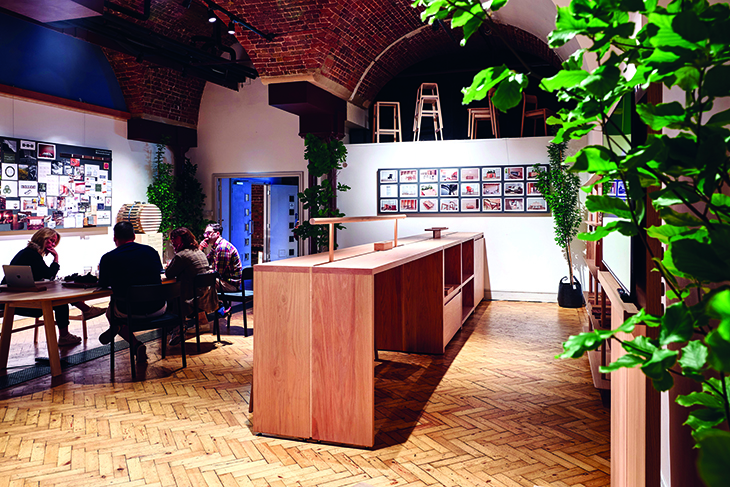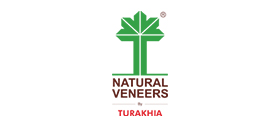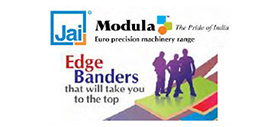Master, apprentices take AHEC’s cherry challenge

ILE comprises benches, tables, lockers, shelves and planters, connected via an innovative timber fixing strip both back-to-back and side-to-side, to optimise office space and facilitate different modes of working.
Dedicated to championing the sustainable use of timber in design and architecture, the American Hardwood Export Council (AHEC) has a track record not only of collaborating with the leading lights of the creative sector, but also of working with the emerging generation to explore the possibilities of under-used woods.
For Clerkenwell Design Week, AHEC did both. Two events during the week last year demonstrated the creative and practical properties of two hardwood varieties that are rarely used in conventional design production: American red oak and low-grade cherry.
The first was a major collaboration with one of the UK’s most prestigious design studios, Foster+Partners Industrial Design, and one of its leading craft furniture makers, Benchmark, on the new ILE modular workspace system.
The second was a showcase of creative experimentation from the country’s design talent of tomorrow: students at Kingston University’s Product and Furniture Design course.
Both projects demonstrated the potential role that often-overlooked materials might play in ensuring a sustainable future for the industry and make the case for looking beyond conventional timber varieties when it comes to making beautiful, functional and high-quality design.
Interlocking elements
Previewed as a part of the British Collection at St James’ Crypt, ILE by Foster+Partners Industrial Design and Benchmark is a flexible family of timber furniture comprising a range of interlocking elements.
The collection was conceived to maximise the use of under-utilised spaces in the workplace – the ‘in-between areas’ that can often be wasted or inefficient.
ILE comprises benches, tables, lockers, shelves and planters, which can be connected via an innovative timber fixing strip both back-to-back and side-to-side, optimising office space and facilitating different modes of working.
The system is designed to accommodate lighting rails and power displays, as well as accessories such as shelves and book ends, at any position on the worktop. With most offices undergoing 10 fitouts in an average 60-year lifespan, this level of adaptability helps maximise the lifespan of the furniture.
ILE makes use of two solid timbers, American red oak and British ash, both of which are practical, affordable, attractive and sustainable. The red oak, sourced from forests in the Northern Appalachians, is notable for its rapid rate of regeneration. Despite the fact it makes up around 18% of the hardwood forest of North America, it is massively under-used.
Cherry project
As a timber, high-grade (knot-free) cherry is widely used by interior designers and architects in high-end joinery and interior architecture. Lower grades provide equally beautiful and sustainable wood and are a great choice for projects that don’t require very long sections, such as kitchen cabinetry, furniture parts, and flooring.
To ensure sustainability, it is crucial to use all parts of a harvested tree, not just the premium grades. To promote this approach, Kingston students were challenged to create furniture using lower grades of American cherry.
By embracing lower grades, the design community can lead the way in sustainable practices, achieving both cost-effectiveness and environmental stewardship. The 50 second-year students of Kingston’s Product & Furniture Design course were presented with offcut low-grade cherry and invited to create new design forms.
The result was an extraordinary collection of furniture and objects that offered fresh, practical and creative perspectives on an overlooked material. From stools and shelving to benches and even a playground see-saw, the body of work produced showcased both the versatility of cherry and the visionary talent of the emerging design generation.
“The next generation of designers, more than any before them, will need to adapt to a new way of thinking about the materials they use and the environmental impact of the designs they produce. This project has also shown that, with imagination, you can make beautiful products from what would be rejected as unsuitable in the commercial world,” concluded David Venables, European Director of AHEC.
Comments

- ‘Red gazelle’ makes window installation easy
- Felder’s solutions for window and door production
- Versatile sliding-folding systems from Hafele
- Door line automation from Woodtech Consultants
- Accutec solutions for uPVC windows
- Jowat’s VOC-free primer for window profile wrapping
- Flexible solutions for doors, windows from SCM
- Tostem introduces Giesta steel doors; calls for dealers
- Folder system by Salice optimises cabinet space
- Turakhia has top-quality veneers for doors
- Mirka has solutions for difficult sanding of doors
- When Lamello’s Cabineo became a game changer
- Digital lacquer embossing for flooring from Hymmen
- Weber sanders help achieve luxury surfaces
- Rehau has designs on growing edge band market
- Samet ties up with Greenply to tap Indian hardware market
- IMA Schelling sets up base in India
- Hettich earns BIS nod for hinges, runners
- Biesse India now a Multi-Material Expert
- The importance of selecting the correct tools
- Indian cabinet maker shines at Lyon WorldSkills
- ‘Collaboration holds the key to success’
- Fibreboard recycling becomes a reality
- MumbaiWood now a recognised destination
- Knock on wood: A bouquet of training courses!
- Ligna 2025: ‘Thinking in circles’
- CIFF-Shanghai focuses on furniture design
- Felder hosts in-house show, Technology Days
- Interzum Forum Italy makes impressive debut
- Koelnmesse ties up for 3-in-1 Jakarta fair
- WOFX: a global hub for innovation and growth
- Events Calendar: industry fairs you must visit
- 3D is printing sustainable housing solutions
- Hard or soft? Researchers discover new wood type
- Master, apprentices take AHEC’s cherry challenge
- ‘Zero-to-launch’ modularity transforming hospitality
- ICA’s Urban Matter is about satin-finish metal effect
- MTC’s ‘Woven timbers’ create waves
- Impact of material in interior design
- Underestimated danger: Sharp edges
- Playing safe on clothing storage units
- ‘Green’, 3D-printed panel floors it!
- Adhesive-free joining of wood, metal
- Energy-efficient manufacturing of fibre-based products
- Rice bran wax: a sustainable alternative
- Dual-side hand sanding block has unique features
- Bio-based products for sustainable development
- ‘Wood Vaulting’ may enhance CO2 sequestration
- Protecting forests through advanced AI
- Forest certification benefits wildlife too!
- Elizure, the Rolls Royce of laminates!
- Rehau unveils new Rauvisio Riviera collection
- Hawa Concepta III: upgrade to seamless functional doors
- Hafele’s RE-Twist locks in on security
- Optimus machines feature tomorrow’s technology today
- Merino unveils cutting-edge offerings
- Ornare launches new premium laminates
- New nesting models from SCM
- Advanced moulder, membrane press from Woodtech
- Greenlam Laminates unveils exclusive display centre in Pune
- EUDR implementation dates may be deferred
- Herman Miller introduces bamboo upholstery
- Altendorf named ‘Brand of the Century’
- Catas to verify its test reports
- Combilift wins two prestigious awards
- Holz-Her management transition
- Replica of the Oval Office opens
- Ozone Blu sets up experience centre
- SCM opens new subsidiary in Slovenia
- VDMA faces business stagnation
- RentoMojo reports strong growth in FY24
- Century Plyboards on expansion mode
- Subhra named DG of FSC
- Meta to assist Skill India Mission
- Sugatsune opens Bengaluru experience centre
- Dieffenbacher acquires Pagnoni
- Pepperfry partners with Infra.Market
- Hafele opens light store in Chandigarh









































